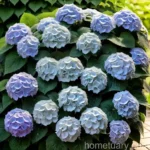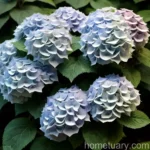Panicle Hydrangea (Hydrangea paniculata ‘SMNHPPH’ LIMELIGHT PRIME) – A Comprehensive Guide

Hydrangea paniculata, commonly known as panicle hydrangea, is a stunning and vibrant flowering plant that has gained popularity for its breathtaking panicles of flowers and low maintenance requirements. In this comprehensive guide, I will delve into the various aspects of panicle hydrangea care, including its culture, uses, water and sunlight requirements, fertilizer, soil, pruning, propagation methods, common diseases, pests, and much more. We will also explore the stunning features and characteristics of the ‘SMNHPPH’ LIMELIGHT PRIME variety of panicle hydrangea.
What is a Panicle Hydrangea?
Panicle hydrangea, scientifically known as Hydrangea paniculata, is a deciduous shrub belonging to the family Hydrangeaceae. It is native to China and Japan and is widely cultivated for its large, showy panicles of flowers that bloom from midsummer through fall. These flowers gradually change in color, creating a stunning visual display in gardens and landscapes.
Key Takeaways – Panicle Hydrangea (Hydrangea paniculata ‘SMNHPPH’ LIMELIGHT PRIME)
Before we dive into the specifics of panicle hydrangea care, let’s take a quick look at the key takeaways regarding this exquisite plant:
- Plant Name: Hydrangea paniculata ‘SMNHPPH’ LIMELIGHT PRIME
- Common Names: Panicle hydrangea, Limelight Prime hydrangea
- Botanical Classification:
- Family: Hydrangeaceae
- Genus: Hydrangea
- Species: H. paniculata
- Key Features:
- Large, showy panicles of flowers
- Deciduous shrub
- Midsummer to fall blooming period
- Easy to grow and maintain
Now, let’s explore the essential aspects of caring for panicle hydrangeas, encompassing culture, uses, and specific requirements for optimal growth and development.
Culture of Panicle Hydrangea
Cultivating panicle hydrangeas involves understanding their specific cultural requirements, including water, sunlight, soil, and other environmental conditions that contribute to their overall well-being.
Uses
Panicle hydrangeas are versatile plants that serve various purposes in landscaping and gardening. Some common uses of panicle hydrangeas include:
- Ornamental Features: They are primarily grown for their stunning ornamental value, featuring large, cone-shaped panicles of flowers that transform in color over the blooming period.
- Hedging and Screening: Their dense growth habit makes them suitable for creating hedges and screens in gardens.
- Cut Flowers: The long-lasting blooms make beautiful additions to floral arrangements, both fresh and dried.
- Pollinator Attraction: The flowers attract pollinators such as bees and butterflies, enhancing the ecological diversity of the garden.
Water Requirements
Proper watering is crucial for the health and vitality of panicle hydrangeas. Understanding their water requirements is essential to prevent issues such as wilting or root rot.
Sunlight
In addition to water, sunlight is a vital factor that influences the growth and blooming of panicle hydrangeas. Adequate sunlight exposure is necessary for robust flowering and overall plant vigor.
Fertilizer
Fertilization is an integral part of nurturing panicle hydrangeas and ensuring their steady growth and development. Selecting the right type of fertilizer and applying it at the appropriate times can significantly impact their overall health and blooming potential.
Soil
The soil composition and structure play a critical role in providing essential nutrients and a conducive growing environment for panicle hydrangeas. Understanding the ideal soil conditions for these plants is essential for their long-term health.
Pruning
Pruning is an essential maintenance task for panicle hydrangeas, contributing to their overall shape, bloom production, and longevity. Proper pruning techniques and timing are crucial to maximize the beauty and health of these plants.
Propagation
Propagation methods enable gardeners and enthusiasts to expand their collection of panicle hydrangeas and share these beautiful plants with others. Understanding the various propagation techniques can help in multiplying desired cultivars.
Container Popularity
Panicle hydrangeas are increasingly being grown in containers for their compact growth habit and striking visual appeal. Exploring their suitability for container gardening is essential for those interested in cultivating them in limited spaces.
Common Diseases
While panicle hydrangeas are relatively low-maintenance plants, they are susceptible to certain diseases that can affect their overall health and blooming performance. Understanding these diseases and their management is crucial for ensuring the longevity of the plants.
Disease Diagnosis
The ability to identify and diagnose common diseases affecting panicle hydrangeas is essential for implementing effective control measures and preserving the overall health of the plants.
Common Pests
Pests can pose a threat to the well-being of panicle hydrangeas, causing damage to foliage, blooms, and overall plant vitality. Recognizing common pests and implementing suitable pest control measures is essential for preventing infestations.
Botanist’s Tips
Drawing from the expertise of botanists and horticulturists, we can uncover valuable tips and insights for successfully growing and caring for panicle hydrangeas. Incorporating these tips into our gardening practices can lead to thriving and beautiful plants.
Fun Facts
Exploring the fascinating and lesser-known aspects of panicle hydrangeas can deepen our appreciation for these remarkable plants. From historical significance to unique botanical features, there is much to discover about these garden favorites.
Links to External Resources
To further expand your knowledge about panicle hydrangeas and enhance your gardening experience, I have compiled a list of curated external resources that offer valuable insights and practical guidance on cultivating and caring for these stunning plants.
I hope this comprehensive guide provides you with a deeper understanding of panicle hydrangeas and equips you with the knowledge to cultivate and care for these remarkable plants in your own garden. Whether you are a seasoned gardener or a novice enthusiast, the enchanting beauty and manageable nature of panicle hydrangeas make them a delightful addition to any landscape.
Happy Gardening!















